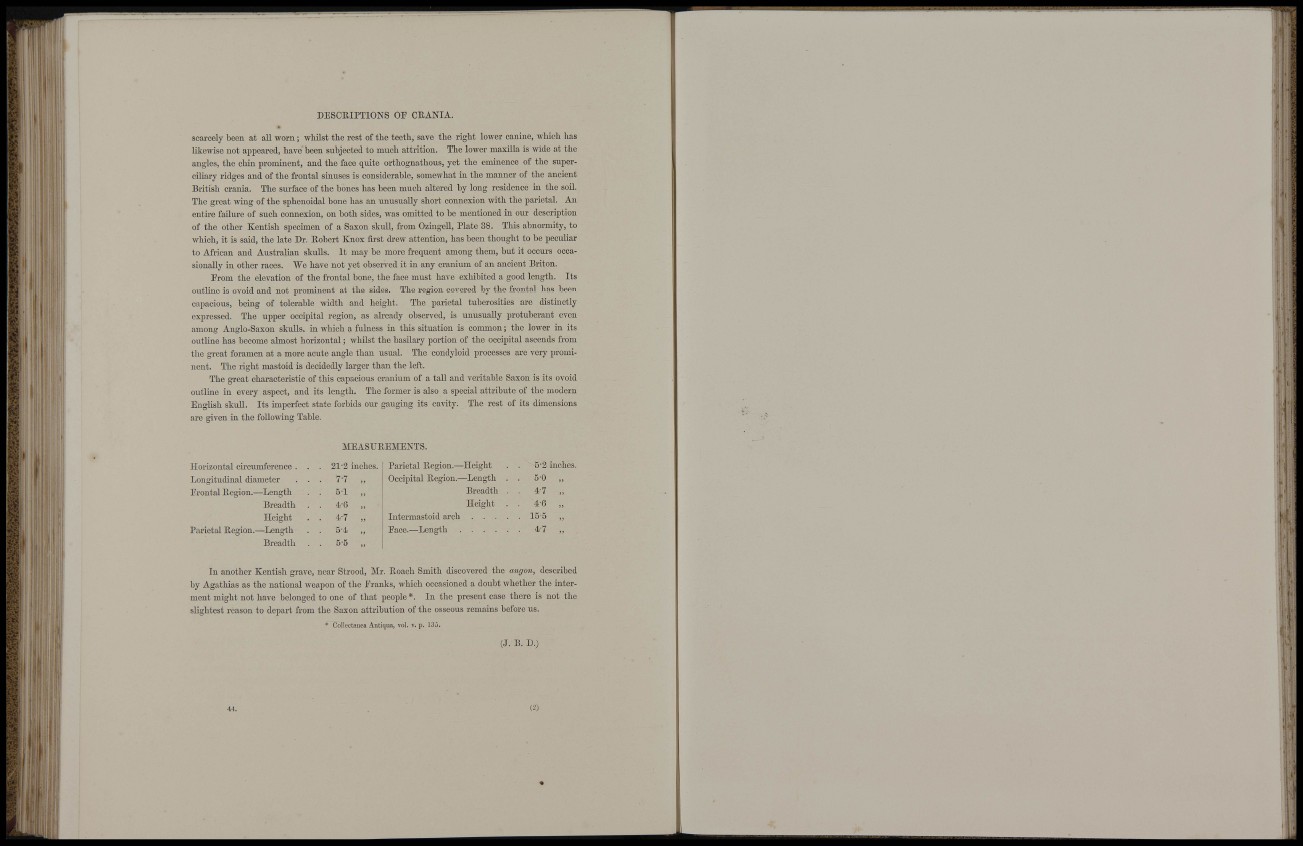
1(! - iI '"
l i i H h - " m, ;
Rlí !il
W\ iüiiii
i ; '
I '
DESCRIPTIONS OF CRANIA.
scarcely been at aU worn; whilst the rest of the teeth, save the right lower canine, which has
likewise not appeared, have been subjected to much attrition. The lower maxilla is wide at the
angles, the chin prominent, and the face quite orthognathous, yet the eminence of the superciliary
ridges and of the frontal sinuses is considerable, somewhat in the manner of the ancient
British crania. The surface of the bones has been much altered by long residence in the soil.
The great wing of the sphenoidal bone has an unusually short connexion with the parietal. An
entire failure of such connexion, on both sides, was omitted to be mentioned in our description
of the other Kentish specimen of a Saxon skuU, fi-om Ozingell, Plate 38. This abnormity, to
which, it is said, the late Dr. Robert Knox fli-st di-ew attention, has been thought to be peculiar
to African and Australian sknUs. It may be more frequent among them, but it occm-s occasionally
in other races. "We have not yet observed it in any cranium of an ancient Briton.
Prom the elevation of the frontal bone, the face must have exhibited a good length. Its
outline is ovoid and not promineiit at the sides. The region covered by the fi'ontal has been
capacious, being of tolerable width and height. The parietal tuberosities are distinctly
expressed. The upper occipital region, as already observed, is unusually protuberant even
among Anglo-Saxon skulls, in. wliich a fulness in this situation is common; the lower in its
outline has become almost horizontal; whilst the basilary portion of the occipital ascends from
the great foramen at a more acute angle than usual. The condyloid processes are very prominent.
The right mastoid is decidedly larger than the left.
The great characteristic of this capacious cranium of a tall and veritable Saxon is its ovoid
outline in every aspect, and its length. The former is also a special attribute of the modern
English skull. Its imperfect state forbids our gauging its cavity. The rest of its dnnensions
are given in the following Table.
L i
.• i
! ' •
I; -
i '
MEASUBEMNTS.
i I :!
Ilorizontal circumference .
Longitiidinal diameter
Erontal Region.—Length
Breadth
Height
Parietal Region.—Length
Breadth
21-2 inches.
7-7 „
5 1 „
4-6 „
4-7 „
5-4 „
5-5 „
Parietal Region.—Height
Occipital Region.—Length
Breadth
Height
Intermastoid arch . . .
Face.—Length . . . .
5-2 inches.
5-0 „
4-7 „
4-6 „
15-5 „
4-7 „
In another Kentish grave, near Strood, Mr. Roach Smith discovered the angon, described
by Agathias as the national weapon of the Franks, which occasioned a doubt whether the interment
might not have belonged to one of that people *. In the present case there is not the
slightest reason to depart from the Saxon attribution of the osseous remains before us.
* Collectanea .-Vntiqua, vol. v. p. 135.
(J. B. D.)
Í - r
! Í
1 1
44. (2)